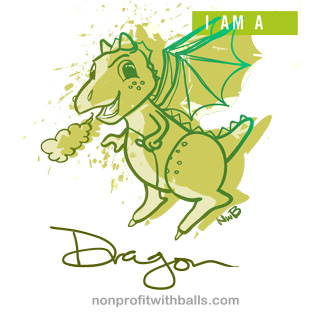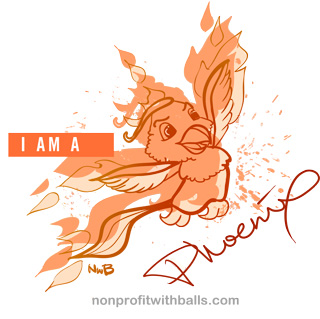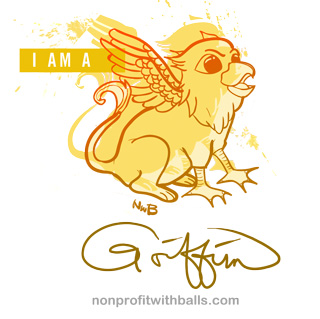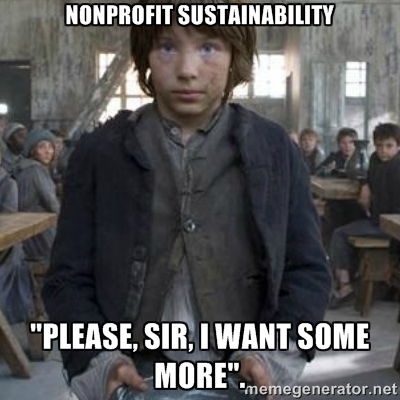 [Note: The set of creatures originally comprised Dragon, Unicorn, Phoenix, and Lion-Turtle. Due to copyright and other reasons, it has been changed.]
[Note: The set of creatures originally comprised Dragon, Unicorn, Phoenix, and Lion-Turtle. Due to copyright and other reasons, it has been changed.]
Most of us in the field have done various “behavioral styles” activities. With so much of our work being relationship-based, it is important for us to understand one another. This will lessen our chances of strangling our coworkers or boss or board members or even some funders or clients.
There are dozens of categorization systems, some using color, directions, or adjectives such as amiables, expressives, drivers, analyticals; or controllers, stabilizers, persuaders, analyzers, etc. Whatever the system, everyone tends to agree that there are four different behavior styles.
It is always good for us to get regular refreshers on what those four styles are. But colors and directions and adjectives are so boring. Here, I’ve relabeled the styles after bad-ass mythical creatures, each awesome (and also sometimes sucky) in their own ways. Find out which style you and the people around you are, and then try to get along with everyone.
How do I know which bad-ass mythical creature I am?
The best way is for you to show this blog post to three or more people, ask them to read it, and then tell you which of these styles most closely describes you. That’s because what we think we are may be completely different from how others perceive us; for instance, I used to think I was an amazing beat-boxer, but based on feedback I was really more like a dying weasel with a spittle problem…
If you’re too lazy to ask three people, just take this one-question quiz below.
When you read the title of this blog post, what was your first thought?
- Whoo hoo, Dragons, Pegacorns, Phoenixes, Griffins! Sounds like a drinking game!
- This is stupid. I don’t have time to read blog posts about work styles. I have stuff to do.
- Hm, this article sounds silly, but I should read it to determine if it has any validity.
- Aw, someone took time to write this blog post. I should read it because they spent so much time working on it.
If your answer is 1, you’re a Phoenix; 2, you’re a Dragon; 3, you’re a Griffin; 4, you’re a Pegacorn.
Note: Everyone tends to have a dominant style. But we all have all styles within us, and they change depending on context. You can be a Dragon at work, but a total Pegacorn at home, for instance. Or you can be a Griffin in the board room, but a Phoenix at a gala. See “Have you flipped your iceberg lately?” for part 2 of this.
Dragon
(Red, North, Fire, Controller, Director, Driver, Dominance, Decisive, Sophia)
“When is this meeting over so we can do stuff?”
 Why Dragons are awesome: Dragons are decisive and like to get stuff done. They are action-oriented and efficient. They hate long meetings, and they’d usually rather juggle live cobras than have to do a wishy-washy ice breaker. Dragons will drive teams to take actions and to be expedient. They wish you would stop reading stupid blog posts like this and do something, like your job.
Why Dragons are awesome: Dragons are decisive and like to get stuff done. They are action-oriented and efficient. They hate long meetings, and they’d usually rather juggle live cobras than have to do a wishy-washy ice breaker. Dragons will drive teams to take actions and to be expedient. They wish you would stop reading stupid blog posts like this and do something, like your job.
Why Dragons sometimes suck: They can be brusque and impatient. In their drive for action and efficiency, they can make mistakes. And they can run over people. Then they might roll their eyes when the people they run over want to talk about their feelings. Feelings are for losers, according to Dragons, because while people are all experiencing emotions and crap, stuff is not getting done.
How to best work with a Dragon: Get to the point quickly. Be action-oriented. Don’t make them share their feelings. Just do your job.
Dragons will have most conflict with: Pegacorns. They find Pegacorns to be indecisive, emotionally weak, easily manipulated, and their focus on harmony and snuggling an annoying waste of time.
Phoenix
(Yellow, West, Air, Persuader, Socializer, Expressive, Influencer, Interactive, Blanche )
“Let’s go to Happy Hour after this meeting!”
Why Phoenixes are awesome:  Phoenixes are visionary, big-picture thinkers. They are optimistic, trustful, and have unlimited energy. They bring fun wherever they go. They are creative and spontaneous. Phoenixes are great at building relationships, since they are charismatic, great talkers, and excellent at convincing people to think and do things differently. They love to get everyone to go out for drinks after work. They like to be around people, and they’re often hilarious.
Phoenixes are visionary, big-picture thinkers. They are optimistic, trustful, and have unlimited energy. They bring fun wherever they go. They are creative and spontaneous. Phoenixes are great at building relationships, since they are charismatic, great talkers, and excellent at convincing people to think and do things differently. They love to get everyone to go out for drinks after work. They like to be around people, and they’re often hilarious.
Why Phoenixes sometimes suck: They can be unfocused and fail to follow up on things that are not fun, which, unfortunately is about 85% of work. They are not good at details and get bored easily. They can be distracted and distracting, and sometimes they burst into songs, which, depending on the timing and frequency, can be either endearing, or make you want to throw a stapler at them.
How to best work with a Phoenix: Get to know them on a personal level, and let them get to know you. Participate in the stuff they suggest, praise them, and go out for drinks with them. (Hint: Phoenixes like to buy people drinks)
Phoenixes will have most conflict with: Griffins. They find Griffins to be way too serious, stuck-up, and boring as hell.
Griffin
(Blue, East, Earth, Analyzer, Thinker, Analytical, Conscientious, Cautious, Dorothy)
“I’ve prepared handouts for everyone for this meeting.”
Why Griffins are awesome:  Griffins are diligent, careful, logical, and accurate. They take time to do their work, so it is usually high quality. They are detailed oriented, often picking up stuff that other people miss. They love processes, data, and well-reasoned arguments. They bring grounding and balance to any team, encouraging everyone pay attention to boring technical crap like objectives and timelines and data. They are not sure this description of them is accurate; they need more time to think about it first.
Griffins are diligent, careful, logical, and accurate. They take time to do their work, so it is usually high quality. They are detailed oriented, often picking up stuff that other people miss. They love processes, data, and well-reasoned arguments. They bring grounding and balance to any team, encouraging everyone pay attention to boring technical crap like objectives and timelines and data. They are not sure this description of them is accurate; they need more time to think about it first.
Why Griffins sometimes suck: They require a lot of time to think and plan, which can be annoying. Also, they keep wanting more and more data, and keep asking questions all the time, like “what’s the budget for this?” and “what was the process for coming up with this budget?” which can be infuriating. Sometimes they seem boring, since they often like to keep work life and personal life separate, meaning they might seem stand-offish when everyone goes out for drinks and they don’t.
How to best work with Griffins: Be specific, thorough, and demonstrate that you have thought thoroughly about stuff after doing research. Be consistent and predictable and don’t seem too impulsive.
Griffins will have most conflict with: Phoenixes. They find the Phoenixes to be silly, narcissistic, drunkards, and time wasters.
Pegacorn
(Green, South, Water, Stabilizer, Relater, Amiable, Steady, Stabilizing, Rose)
“Let’s make ‘snuggling’ the first item on the agenda.”
Why Pegacorns are awesome: Pegacorns are considerate, thoughtful, and good at listening.  They like harmony and use their pegacorn powers to help people get along. Pegacorns will always be on the lookout to make sure everyone is comfortable and no one feels left out. They are good at mediating conflicts and getting people to hold hands and snuggle and crap like that. Even though they are gentle, they will stab injustice in the face with their horns of equity.
They like harmony and use their pegacorn powers to help people get along. Pegacorns will always be on the lookout to make sure everyone is comfortable and no one feels left out. They are good at mediating conflicts and getting people to hold hands and snuggle and crap like that. Even though they are gentle, they will stab injustice in the face with their horns of equity.
Why Pegacorns sometimes suck: Pegacorns are always searching for consensus, so they can be indecisive, needing to check in with everyone. They can be conforming, insecure, and wishy-washy. Wanting to avoid conflict, sometimes they bottle up their feelings, absorbing the stress until it reaches a breaking point, and then they explode, getting messy pegacorn bits all over the place.
How to best work with a Pegacorn: Do what you say you’re going to do, be kind and considerate to everyone, tell them you appreciate them.
Unicorns will have most conflict with: Dragons. They find Dragons to be insensitive and thoughtless clods who don’t value others’ feelings.
***
I hope that was helpful. Remember, no one mythical creature is better than any other. A good team will have at least one of each of the styles. And also, keep in mind that while we each have one dominant style, we can (and should) learn other styles and transform into different mythical creatures as situations demand. If we can all learn each other’s styles and learn to work with one another, maybe, just maybe, we will survive planning the next annual fundraising event.
***
Make Mondays suck a little less. Get a notice each Monday morning when a new post arrives. Subscribe to NWB by scrolling to the top right of this page and enter in your email address. Also, join the NWB Facebook community for daily hilarity.
Donate, or give a grant, to Vu’s organization, Rainier Valley Corps, which has the mission of bringing more leaders of color into the nonprofit sector and getting diverse communities to work together to address systemic issues.
Also, join Nonprofit Happy Hour, a peer support group on Facebook, and if you are an ED/CEO, join ED Happy Hour. These are great forums for when you have a problem and want to get advice from colleagues, or you just want to share pictures of unicorns. Check them out.
Oh, and support the maintenance of this website by buying NWB t-shirts and mugs and other stuff.
 Hi everyone. For the first time in my eight years with the organization, my board has decided to conduct a performance review. These are two words that send chills up and down every Executive Director’s spine, on par with “budget deficit” and “annual event.” The board had a clandestine meeting three weeks ago to talk about my performance as an ED. Soon they will meet with me to deliver feedback.
Hi everyone. For the first time in my eight years with the organization, my board has decided to conduct a performance review. These are two words that send chills up and down every Executive Director’s spine, on par with “budget deficit” and “annual event.” The board had a clandestine meeting three weeks ago to talk about my performance as an ED. Soon they will meet with me to deliver feedback.









